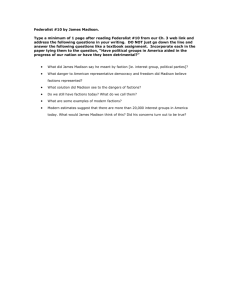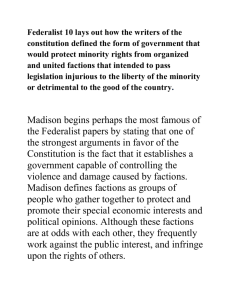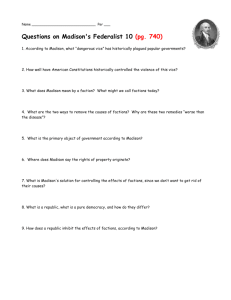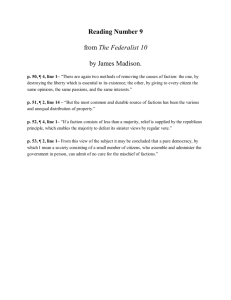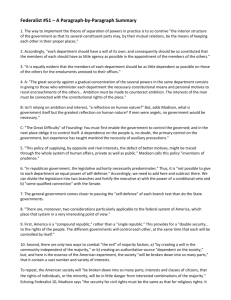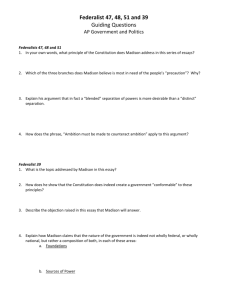File
advertisement
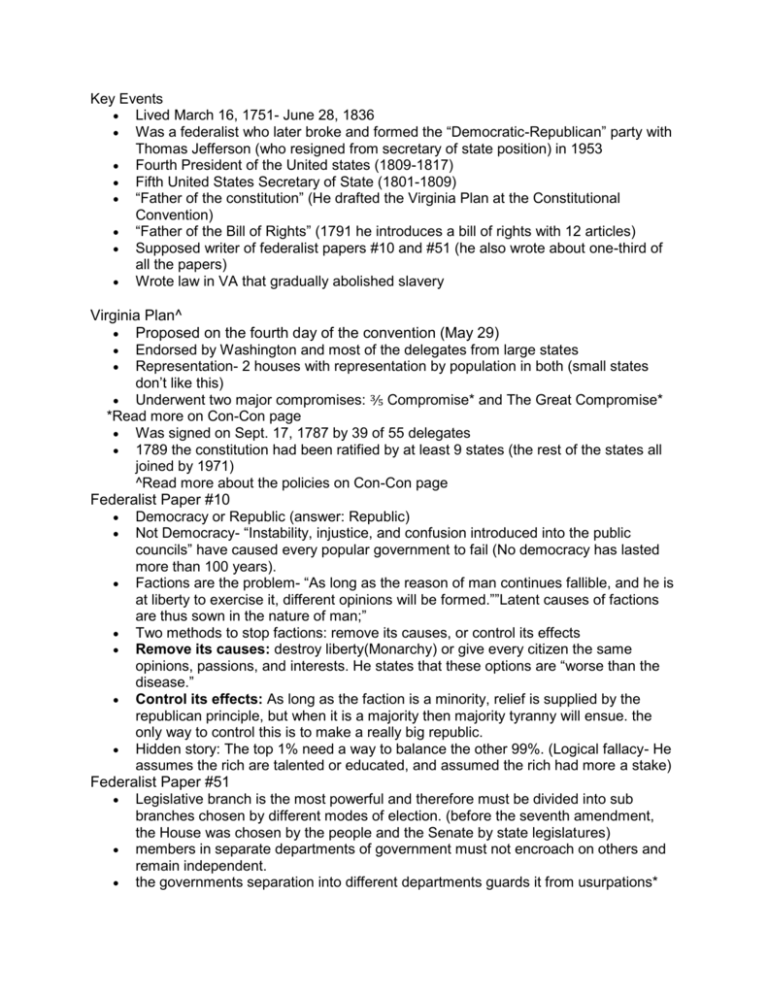
Key Events Lived March 16, 1751- June 28, 1836 Was a federalist who later broke and formed the “Democratic-Republican” party with Thomas Jefferson (who resigned from secretary of state position) in 1953 Fourth President of the United states (1809-1817) Fifth United States Secretary of State (1801-1809) “Father of the constitution” (He drafted the Virginia Plan at the Constitutional Convention) “Father of the Bill of Rights” (1791 he introduces a bill of rights with 12 articles) Supposed writer of federalist papers #10 and #51 (he also wrote about one-third of all the papers) Wrote law in VA that gradually abolished slavery Virginia Plan^ Proposed on the fourth day of the convention (May 29) Endorsed by Washington and most of the delegates from large states Representation- 2 houses with representation by population in both (small states don’t like this) Underwent two major compromises: ⅗ Compromise* and The Great Compromise* *Read more on Con-Con page Was signed on Sept. 17, 1787 by 39 of 55 delegates 1789 the constitution had been ratified by at least 9 states (the rest of the states all joined by 1971) ^Read more about the policies on Con-Con page Federalist Paper #10 Democracy or Republic (answer: Republic) Not Democracy- “Instability, injustice, and confusion introduced into the public councils” have caused every popular government to fail (No democracy has lasted more than 100 years). Factions are the problem- “As long as the reason of man continues fallible, and he is at liberty to exercise it, different opinions will be formed.””Latent causes of factions are thus sown in the nature of man;” Two methods to stop factions: remove its causes, or control its effects Remove its causes: destroy liberty(Monarchy) or give every citizen the same opinions, passions, and interests. He states that these options are “worse than the disease.” Control its effects: As long as the faction is a minority, relief is supplied by the republican principle, but when it is a majority then majority tyranny will ensue. the only way to control this is to make a really big republic. Hidden story: The top 1% need a way to balance the other 99%. (Logical fallacy- He assumes the rich are talented or educated, and assumed the rich had more a stake) Federalist Paper #51 Legislative branch is the most powerful and therefore must be divided into sub branches chosen by different modes of election. (before the seventh amendment, the House was chosen by the people and the Senate by state legislatures) members in separate departments of government must not encroach on others and remain independent. the governments separation into different departments guards it from usurpations* *Usurp- illegitimate claim to power The Virginia Plan o Presented at the Constitutional Convention of 1787 Convention a result of Bankers and Plantation owners call for a stronger gov’t to protect them from uprisings (i.e. Shays’ Rebellion) o Bicameral plan of Govt. o Representation in both houses to be determined by population o At the convention, Madison’s Virginia Plan was initially adopted. However, during a line by line review/approval the delegates disagreed over representation. other “plans” were then presented, each laying out an alternate method of determining representation o VA plan was an entire constitution, unlike CT and NJ plans Political founding father / Architect of the Government o Father of the Constitution o Father of the Bill of Rights War of 1812 Wrote law for VA that gradually abolished slavery. Wrote Federalist Papers #10 & #51. Argued that no democracy lasted longer than The 100 years, but there are republics that have lasted centuries. Factions are bad, there are only two solutions: 1) Get rid of liberty (monarchy) “Liberty is the air to the fire of faction” 2) Or create a really big republic They had just done the revolution to get rid of the monarchy. Federalist Paper #10: Written by Madison. Said, “No Democracy has lived 100 years, but some republics have lasted for centuries.” Two solutions to factions: Create a large republic, or get rid of liberty. Said he doesn’t agree with democracy- Articles of Confederation, or monarchy- The NY plan. Liberty are the air to the fire of factions. With a large republic, there will be many minority groups, this will not allow majority tyranny. Said majority tyranny is worse than a monarchy. Hidden story: The top 1% needs a way to balance the 99%. Here he made two miscalculations: He talks about how the rich were either talented or educated, and said that the rich have more at stake- logical fallacy. That’s why he trusted the 1%. The Bill of Rights: Madison and Mason- Madison was a federalist, Mason was an anti-federalist, both from Virginia. Madison is the house representative from VA. They wrote 12, congress took 10. The two they didn’t take- COngress can’t give themselves raised, but can give to future congress members. The house should represent the population, including demographically. IN 1793, 4 years after he was in the4 house of reps. Said “Congress is made of the most contemptuous men I have ever seen. Who would sell out their country for their own interests?” Purposefully made 10th amendment to assure power not mentioned in any document to the citizens and the states. All the power not given to the government or prohibited from the states in any document was left to the states. Madison teams up with Jefferson, and they make a democratic-republic party. The Democratic-Republican party: Madison went to Jefferson- because he knew he messed up with the government, and he wanted to fix it. Closer to democracy, within the confines of a republic. The Virginia resolution: The Alien and sedition act- clearly against the first amendment, so they quoted the 10th amendment, and voted within the states. Jefferson went to Kentucky, where they determined the acts were unconstitutional. Madison wrote a similar document through VA. Congress wrote a law to force the states to follow the acts, states said the law was unconstitutional and threatened to secede. Madison’s Presidency: Jefferson switches sides, right after, Madison is elected president. B/c Jefferson switched sides, Madison was left in turmoil at the start of his presidency. Because we sided with France, it broke the Treaty of Paris, signed in 1783. Great Britain starts attacking our ships and kidnapping prisoners. Because of this, Madison is losing popularity. Madison feels he deserves a second term. He realizes the American people will not vote against a sitting president at wartime. In October of 1812, he declares war against Britain. In 1813, he wins the election. Then, Britain pummels the US for two years, burns Washington down except for the Marine headquarters because of honor, then Madison offers surrender to Great Britain, Britain declines, because it would destroy the country. They don’t want the American people back in Great Britain, so to preserve the spirit of our country, they continue killing us.They also don’t want us to fail, so they continue the war, then lose the battle of New Orleans on purpose to convince the American people that we won the war.
